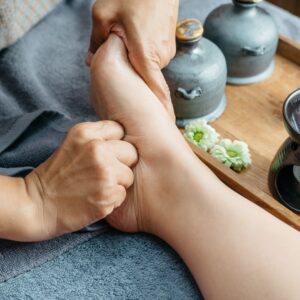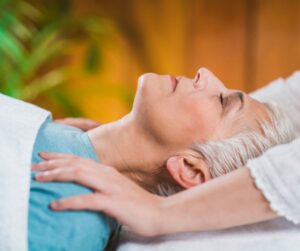After a strenuous workout, it’s common to experience sore muscles, stiffness, and tension throughout the body. One of the most effective ways to alleviate these symptoms is through massage therapy. Massaging sore muscles after a workout can help to increase blood flow, reduce inflammation, and release tension in the muscles, promoting faster recovery and reducing the risk of injury.
In this article, we will explore the benefits of massaging sore muscles after a workout and provide tips on how to properly massage different parts of the body to promote healing and relaxation.
Whether you’re a seasoned athlete or just starting a new workout routine, learning how to effectively massage your sore muscles can help you feel better and perform at your best.
Check out our latest posts:
- Menopause Frizzy Hair Treatment: Effective Solutions for Smooth Hair
- Sore Nails After Acrylics Removed: What You Need to Know
- Paper Thin Nails After Acrylics: Understanding Causes and Remedies
- Mature Hairline VS Receding Hair: Understanding the Difference
- Toothpaste on Pimples Overnight: Does It Work?
Does massage help sore muscles after exercise?
Yes, massage can be very effective in helping to relieve sore muscles after exercise. When you exercise, your muscles can become tight and sore due to the accumulation of lactic acid and other metabolic waste products. Massage helps to increase blood flow to the muscles, which can help to flush out these waste products and reduce inflammation. Massage can also help to release tension in the muscles, promoting relaxation and reducing the risk of injury.
What type of massage is best for sore muscles?
There are several different types of massage that can be beneficial for sore muscles after exercise:
- Swedish massage
- Deep tissue massage
- Sports massage
are all effective techniques for promoting muscle recovery and reducing soreness. It’s important to note that while massage can be helpful, it’s not a replacement for proper rest, hydration, and nutrition.
In order to fully recover from exercise, it’s important to give your body the time and resources it needs to heal.
How does massage help sore muscles?
Massage can help sore muscles in several ways, including:
- Increases blood flow to the muscles, which promotes healing and reduces inflammation.
- Helps to break up and flush out metabolic waste products that can contribute to muscle soreness.
- Reduces muscle tension and promotes relaxation, which can help to alleviate soreness and prevent injury.
- Stimulates the release of endorphins, which are natural painkillers that can help to reduce discomfort and promote a sense of well-being.
- Increases range of motion and flexibility in the muscles, which can help to prevent injury and improve athletic performance.
- Improves lymphatic drainage, which can help to remove toxins from the body and reduce swelling.
- Can help to reduce the build-up of scar tissue, which can limit mobility and contribute to chronic pain.
- Can help to promote a sense of relaxation and reduce stress, which can contribute to overall health and well-being.
What is Delayed onset muscle soreness (DOMS)?
Delayed onset muscle soreness (DOMS) is a type of muscle pain and stiffness that occurs after exercise or other physical activity. It typically occurs a day or two after the activity and can last for several days.
DOMS is characterized by tenderness, stiffness, and aching in the muscles that were worked during the activity. The exact cause of DOMS is not well understood, but it is believed to be caused by small tears in the muscle fibers that occur during exercise, along with an accumulation of metabolic waste products in the muscle tissue.
The DOMS is a normal response to physical activity and is not usually a cause for concern, but it can be uncomfortable and may limit mobility and athletic performance until the muscles have fully recovered.
The effects of massage on delayed onset muscle soreness
Here are some points on the effects of massage on delayed onset muscle soreness (DOMS):
- Reduces muscle soreness and stiffness, helping to improve range of motion and flexibility.
- Promotes the removal of waste products from the muscles, reducing inflammation and aiding in recovery.
- Increases blood flow to the affected areas, which can promote healing and reduce pain.
- Can help to reduce the production of cytokines, which are markers of inflammation associated with DOMS.
- Can stimulate the release of endorphins, which are natural painkillers that can help to reduce discomfort.
- Can improve muscle function and performance, helping athletes to recover more quickly and perform at their best.
- Can help to reduce the risk of injury by improving muscle flexibility and reducing tension.
- Can provide a sense of relaxation and reduce stress, which can contribute to overall health and well-being.
Does massaging sore muscles affect muscle growth?
While massage can be beneficial for reducing soreness and promoting muscle recovery, it is not likely to have a significant impact on muscle growth. Muscle growth occurs primarily through a process known as hypertrophy, which involves an increase in the size and number of muscle fibers in response to exercise and other stimuli. While massage can help to reduce tension in the muscles and promote healing and recovery, it is not a direct stimulus for muscle growth.
That being said, massage can indirectly support muscle growth by reducing soreness and stiffness, which can help athletes to train more effectively and consistently. By promoting recovery and reducing the risk of injury, massage can help athletes to maintain a regular training schedule and achieve their goals more quickly and efficiently. In addition, massage can help to promote relaxation and reduce stress, which can contribute to overall health and well-being
Why does massaging sore muscles feel good but hurt?
Massaging sore muscles can feel both good and hurt at the same time because of the complex interaction between nerve fibers, muscle tissue, and pain receptors in the body. When you massage sore muscles, you are applying pressure and manipulating the tissues, which can help to improve blood flow and reduce tension. This can create a pleasurable sensation and a sense of relief in the muscles.
However, at the same time, massage can also stimulate the nerve fibers that are responsible for transmitting pain signals to the brain. This can cause some discomfort or even pain, especially if the muscles are very sore or tender. Additionally, if the massage is too aggressive or applied with too much pressure, it can exacerbate the soreness and cause additional discomfort.
Overall, while massaging sore muscles can feel good and provide some relief, it is important to be gentle and cautious when doing so, and to pay attention to your body’s signals to avoid causing further injury or discomfort.
Conclusion
In conclusion, massaging sore muscles after a workout can be a highly effective way to promote healing, reduce tension and stiffness, and support overall athletic performance and well-being. There are a variety of techniques and approaches that can be used to massage sore muscles, including Swedish massage, deep tissue massage, and trigger point therapy, among others.
By understanding the benefits and limitations of these different techniques and working with a qualified massage therapist or healthcare provider, athletes and fitness enthusiasts can optimize their recovery and get back to training more quickly and effectively.
Additionally, by incorporating massage into their regular routine, athletes can promote long-term health and wellness, improve their flexibility and range of motion, and reduce the risk of injury over time.





